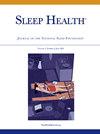Automatic sleep staging based on 24/7 EEG SubQ (UNEEG medical) data displays strong agreement with polysomnography in healthy adults
IF 3.4
2区 医学
Q2 CLINICAL NEUROLOGY
引用次数: 0
Abstract
Goal and aims
Performance evaluation of automatic sleep staging on two-channel subcutaneous electroencephalography.
Focus technology
UNEEG medical’s 24/7 electroencephalography SubQ (the SubQ device) with deep learning model U-SleepSQ.
Reference method/technology
Manually scored hypnograms from polysomnographic recordings.
Sample
Twenty-two healthy adults with 1-6 recordings per participant. The clinical study was registered at ClinicalTrials.gov with the identifier NCT04513743.
Design
Fine-tuning of U-Sleep in 11-fold cross-participant validation on 22 healthy adults. The resultant model was called U-SleepSQ.
Core analytics
Bland-Altman analysis of sleep parameters. Advanced multiclass model performance metrics: stage-specific accuracy, specificity, sensitivity, kappa (κ), and F1 score. Additionally, Cohen’s κ coefficient and macro F1 score. Longitudinal and participant-level performance evaluation.
Additional analytics and exploratory analyses
Exploration of model confidence quantification. Performance vs. age, sex, body mass index, SubQ implantation hemisphere, normalized entropy, transition index, and scores from the following three questionnaires: Morningness-Eveningness Questionnaire, World Health Organization’s 5-item Well-being Index, and Major Depression Inventory.
Core outcomes
There was a strong agreement between the focus and reference method/technology.
Important supplemental outcomes
The confidence score was a promising metric for estimating the reliability of each hypnogram classified by the system.
Core conclusion
The U-SleepSQ model classified hypnograms for healthy participants soon after implantation and longitudinally with a strong agreement with the gold standard of manually scored polysomnographics, exhibiting negligible temporal variation.
基于全天候 EEG SubQ(UNEEG 医疗)数据的自动睡眠分期与健康成年人的多导睡眠图显示出很强的一致性。
目标和目的对双通道皮下脑电图的自动睡眠分期进行性能评估:重点技术:UNEEG medical 的 24/7 全天候脑电图 SubQ(SubQ 设备)与深度学习模型 U-SleepSQ:参考方法/技术:从多导睡眠图记录中手动评分催眠图:22名健康成年人,每人1-6次记录。该临床研究已在 ClinicalTrials.gov 注册,标识符为 NCT04513743:设计:对 U-Sleep 进行微调,对 22 名健康成人进行 11 倍交叉验证。结果模型称为 U-SleepSQ:核心分析:睡眠参数的Bland-Altman分析。高级多分类模型性能指标:特定阶段的准确性、特异性、灵敏度、kappa (κ) 和 F1 分数。此外,还有 Cohen's κ 系数和宏观 F1 分数。纵向和参与者层面的绩效评估。其他分析和探索性分析:探索模型置信度量化。性能与年龄、性别、体重指数、SubQ 植入半球、归一化熵、过渡指数以及以下三个问卷的得分之间的关系:核心结果:重要补充结果:核心结论:U-SleepSQ 模型可对每个催眠图进行分类:核心结论:U-SleepSQ 模型可对植入后不久的健康参与者的催眠图进行纵向分类,与人工评分多导睡眠图这一黄金标准具有很高的一致性,其时间变化可忽略不计。
本文章由计算机程序翻译,如有差异,请以英文原文为准。
求助全文
约1分钟内获得全文
求助全文
来源期刊

Sleep Health
CLINICAL NEUROLOGY-
CiteScore
6.30
自引率
9.80%
发文量
114
审稿时长
54 days
期刊介绍:
Sleep Health Journal of the National Sleep Foundation is a multidisciplinary journal that explores sleep''s role in population health and elucidates the social science perspective on sleep and health. Aligned with the National Sleep Foundation''s global authoritative, evidence-based voice for sleep health, the journal serves as the foremost publication for manuscripts that advance the sleep health of all members of society.The scope of the journal extends across diverse sleep-related fields, including anthropology, education, health services research, human development, international health, law, mental health, nursing, nutrition, psychology, public health, public policy, fatigue management, transportation, social work, and sociology. The journal welcomes original research articles, review articles, brief reports, special articles, letters to the editor, editorials, and commentaries.
 求助内容:
求助内容: 应助结果提醒方式:
应助结果提醒方式:


